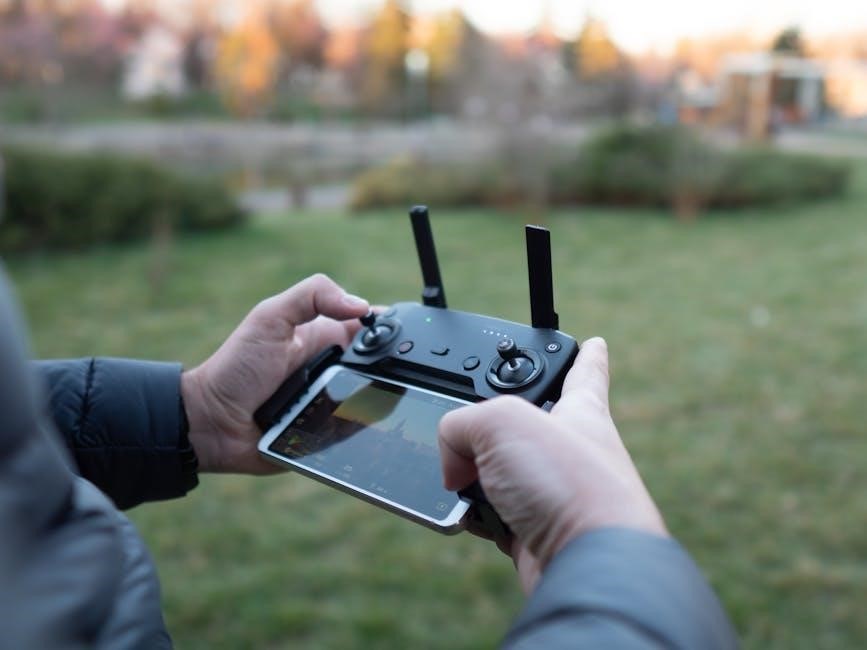can you get remote start on a manual
Remote start technology offers convenience for drivers, allowing vehicles to start via key fob or app. While commonly used with automatics, manual transmissions pose unique challenges.
What is a Remote Start System?
A remote start system is a device that enables vehicle owners to start their car’s engine from a distance using a key fob, smartphone app, or other remote device. This technology enhances convenience by allowing drivers to preheat or precool their vehicle before entry, especially in extreme weather conditions. For manual transmissions, remote start systems often require specific safety protocols, such as ensuring the vehicle is in neutral gear and engaging the parking brake, to prevent accidental movement or accidents.
Benefits of Remote Start
Remote start systems offer unparalleled convenience and comfort, allowing drivers to start their vehicles from a distance. This feature is especially valuable in extreme weather, enabling preheating or precooling before entry. For manual transmissions, modern systems ensure safe operation by requiring specific protocols, such as neutral gear and parking brake engagement. These systems also enhance security and reduce wear on the engine. Users appreciate the ability to start their car remotely, particularly in harsh climates, making it a practical upgrade for both automatic and manual vehicles.

How Remote Start Systems Work
Remote start systems activate your car’s engine via a key fob or app, requiring the vehicle to be in neutral with safety features like reservation mode engaged.
Basic Principles
Remote start systems rely on specific conditions to ensure safe operation. For manual transmissions, the vehicle must be in neutral gear with the parking brake engaged. Modern systems verify these conditions before starting the engine, often requiring a specific sequence of actions, such as shifting to neutral and setting the brake. Reservation mode is a key feature, ensuring the car doesn’t start unless these safety protocols are met. This prevents accidental movement and potential damage or harm.
Neutral Gear Requirement
Remote starting a manual transmission vehicle requires the car to be in neutral gear to ensure safety. Modern systems enforce this by requiring the driver to shift into neutral and engage the parking brake before exiting. This prevents accidental movement when the engine starts. If the vehicle isn’t in neutral, the remote start system won’t activate, safeguarding against unintended motion. This requirement is critical for manual transmissions, as starting in gear could lead to the car moving without a driver.

Safety Considerations
Remote starting a manual transmission requires careful setup to ensure the vehicle doesn’t move unexpectedly. Reservation mode and neutral gear verification are essential to prevent accidents and liability issues.
Reservation Mode
Reservation mode is a safety feature for remote starting manual transmissions. It requires drivers to follow a specific sequence: putting the vehicle in neutral, setting the parking brake, and exiting. Once completed, the car enters a reserved state, allowing remote start only if these conditions are met. This prevents accidental starts while in gear, ensuring the vehicle remains stationary. Modern systems enforce this mode to minimize risks, making remote start safe for manual transmissions when properly configured and used.
Alarm Systems
Alarm systems integrated with remote start add an extra layer of security for manual transmissions. They monitor the vehicle’s state, ensuring it doesn’t move during remote start. If unauthorized movement is detected, the alarm triggers, preventing theft or accidents. These systems often include features like accelerometers and door sensors, enhancing safety and preventing unintended starts while in gear, thus providing peace of mind for owners of manual transmission vehicles equipped with remote start technology.

Installation Considerations
Installing a remote start on a manual transmission requires careful setup to ensure safety and functionality. Professional installation is highly recommended to avoid potential risks and ensure proper integration with the vehicle’s systems.
Professional Installation
Professional installation is highly recommended for remote start systems on manual transmissions. Experts ensure safety by implementing features like reservation mode, neutral gear sensors, and clutch interlock systems. These measures prevent accidental starts and ensure the vehicle is in a safe state before remote starting. Proper setup by professionals minimizes risks associated with manual transmissions, providing peace of mind and reliable functionality.
DIY Installation
DIY installation for a remote start on a manual transmission requires careful planning and technical knowledge. Owners must ensure the vehicle is in neutral and the parking brake is engaged before starting. Modern systems often include safety features like reservation mode, which prevents remote starting in gear. However, improper installation can lead to accidental starts or legal issues. Detailed instructions and manufacturer support are crucial for a successful DIY setup to avoid potential risks.

Types of Remote Start Systems
Remote start systems are available as aftermarket or factory-installed. Aftermarket systems offer flexibility, including for manual transmissions, while factory systems are tailored to specific vehicles.
Aftermarket Systems
Aftermarket remote start systems are versatile and widely available for manual transmissions. They often include advanced features like two-way communication, ensuring safe operation. These systems require specific installation steps, such as neutral gear confirmation and reservation mode activation, to prevent accidental starts. Brands like Compustar and Viper offer reliable options, providing convenience and peace of mind for manual transmission vehicle owners. Professional installation is recommended to ensure safety and proper functionality.
Factory-Installed Systems
Factory-installed remote start systems are typically designed for automatic transmissions due to safety concerns with manual transmissions. Many manufacturers avoid offering this feature on manual vehicles to prevent accidental starts and potential liability issues. However, some newer models may include advanced systems that integrate with manual transmissions, ensuring safe operation through specific protocols. Always consult the manufacturer’s guidelines to confirm compatibility and functionality.
Compatibility with Manual Transmissions
Remote start systems can be installed on manual transmissions with proper safety measures. Modern systems require specific protocols to ensure the vehicle is in neutral before starting remotely.
Why Manufacturers Avoid It
Manufacturers often avoid offering remote start on manual transmissions due to safety risks. Without proper safeguards, vehicles could start in gear, leading to unintended movement. Liability concerns also play a role, as accidents caused by improper use could fall on the manufacturer. These risks are amplified in manual transmissions, where the system must ensure the vehicle is in neutral before starting. Such challenges make factory-installed remote start less common in manual vehicles, though aftermarket solutions exist with added safety features.
How Aftermarket Systems Handle It
Aftermarket remote start systems for manuals use specific safety protocols. They often require the vehicle to be in neutral and the parking brake engaged before starting. Some systems incorporate reservation mode, ensuring the car is securely configured. Advanced features like clutch interlock systems prevent accidental starts in gear. These measures reduce risks, making remote start viable for manual transmissions when installed correctly. Modern systems also provide feedback to the user, ensuring safe operation and preventing unintended movement of the vehicle.
Advantages of Remote Start for Manual Vehicles
Remote start offers convenience, comfort, and ease of use for manual vehicles, allowing preheating or cooling. It enhances the driving experience, especially in extreme weather, and reduces wear on the engine by starting in neutral, making it a practical upgrade for manual car owners.
Convenience
Remote start systems offer unparalleled convenience, allowing drivers to start their manual transmission vehicles without physical interaction. This eliminates the need to exit a warm building or brave harsh weather conditions. With the ability to preheat or precool the vehicle, drivers can enjoy a comfortable cabin upon entry. Additionally, modern systems often include two-way communication, providing confirmation that the vehicle has started successfully. This feature enhances peace of mind and streamlines the process, making it a practical solution for everyday use.
Comfort
Remote start systems significantly enhance comfort by allowing drivers to preheat or precool their manual transmission vehicles. This feature is especially beneficial in extreme weather, ensuring a warm cabin in winter or a cool one in summer. By starting the engine remotely, drivers can enter a vehicle that is already at a comfortable temperature, reducing the need to wait for heating or cooling systems to activate. This convenience is particularly advantageous for individuals with mobility challenges or those seeking a more relaxing driving experience.
Potential Risks and Challenges
Remote starting manual vehicles risks accidental movement if not in neutral. Improper installation or driver error can lead to unintended starts, posing safety and liability concerns.
Accidental Start
The primary risk with remote starting manual vehicles is accidental movement if the car isn’t in neutral. Stories like a mechanic pressing the remote start on a customer’s RSX, which wasn’t in neutral, highlight this danger. Modern systems often require specific safety protocols, but human error can still lead to incidents. Liability concerns arise, especially if improper installation or driver negligence causes accidents. While safety features exist, the potential for mishaps remains, emphasizing the need for careful installation and user awareness.
Liability Issues
Liability issues arise with manual transmission remote starts, as manufacturers like Subaru avoid offering it due to safety concerns. Aftermarket systems shift liability to installers or owners. A technician’s mistake with an Infiniti G35 Coupe, which accidentally rolled into vehicles, underscores potential risks. Proper installation is critical to prevent such incidents, but even then, user error can lead to legal consequences, making insurance and legal responsibility key considerations for manual transmission remote start users.

Overcoming Challenges
Neutral gear sensors and clutch interlock systems address manual transmission risks, ensuring vehicles cannot remote start in gear, thus preventing accidental movement and enhancing safety;
Neutral Gear Sensors
Neutral gear sensors are critical for remote-starting manual transmissions. They ensure the vehicle is in neutral before starting, preventing accidental movement. These sensors confirm the transmission’s position, enabling safe remote starts. By verifying neutral gear, they eliminate the risk of the car moving unexpectedly. This technology integrates seamlessly with reservation mode, offering an additional layer of safety. Neutral gear sensors are essential for manual transmission remote starts, providing peace of mind and preventing potential accidents.
Clutch Interlock Systems
Clutch interlock systems prevent remote starting unless the clutch is fully disengaged and neutral is confirmed. This ensures the vehicle won’t move when started remotely. By requiring the clutch pedal to be pressed, these systems add a layer of safety, reducing the risk of accidental starts in gear. They work alongside neutral gear sensors to enhance security and provide a reliable solution for manual transmissions, ensuring smooth and safe remote start functionality without compromising user control or vehicle safety.
Legal and Liability Aspects
Manufacturers often avoid remote starts for manuals due to liability risks. Aftermarket systems shift liability to installers or owners, emphasizing proper installation and safety protocols to minimize risks.
Manufacturer Policies
Most manufacturers avoid offering factory-installed remote start for manual transmissions due to liability concerns. They prioritize safety, as manual vehicles in gear pose risks if accidentally started. Aftermarket systems exist, but manufacturers like FCA explicitly exclude manual transmissions from factory remote start features, highlighting potential legal implications. This cautious approach emphasizes driver responsibility and safety, reflecting industry-wide practices to minimize accidents and legal exposure.
User Responsibility
With manual transmission remote starts, users must ensure vehicles are in neutral and parking brakes are engaged. Proper setup prevents accidents, as starting in gear can lead to unintended movement. Owners are urged to follow installation and usage guidelines meticulously, prioritizing safety to avoid liability. Regular checks and adherence to manufacturer instructions are crucial to harness the convenience responsibly and mitigate risks associated with remote starting manual vehicles.

User Experiences and Testimonials
Drivers share mixed feedback on manual transmission remote starts. Some praise convenience in cold weather, while others recount incidents of unintended movement, highlighting caution and proper installation’s importance.
Positive Feedback
Many users praise remote start systems for manual transmissions, highlighting convenience and comfort in extreme weather. Drivers appreciate features like two-way communication, ensuring the vehicle starts safely. Proper installation prevents accidents, offering peace of mind. Owners enjoy preheating or cooling their cars without physical effort, making daily commutes easier. The technology’s reliability and ease of use are frequently commended, especially in colder climates where warming up the engine before driving is essential. Positive experiences often emphasize how these systems enhance overall driving comfort and accessibility.
Cautionary Tales
Some users share cautionary tales about remote starts on manuals, citing risks of accidental starts when vehicles aren’t in neutral. Incidents where cars rolled or moved unexpectedly highlight safety concerns. Proper installation and user adherence to protocols are critical to prevent such mishaps. Stories of installations gone wrong emphasize the importance of professional setup and strict safety measures to avoid liability issues and potential accidents. These experiences underscore the need for vigilance and responsibility when using remote start technology on manual transmissions.

DIY vs Professional Installation
DIY remote start installation on manuals can be risky due to complexity, while professional installers ensure safety and proper functionality, minimizing potential errors and liabilities.
Pros and Cons
DIY installation saves money but risks improper setup, leading to safety issues. Professional installation ensures reliability and safety, though at a higher cost. Manual transmissions require precise configuration to prevent accidental starts, making professional installation highly recommended. Aftermarket systems offer advanced features but may void warranties. Balancing cost, convenience, and safety is crucial for manual transmission remote start solutions.

The Future of Remote Start Technology
Advancements in remote start systems are focusing on enhanced safety and integration with smart devices, ensuring seamless control and improved user experiences for manual transmissions.
Advances in Safety
Modern remote start systems for manuals now include advanced safety features such as neutral gear verification and reservation mode. These technologies ensure vehicles cannot start in gear, preventing accidents.
Integration with Smart Devices
Remote start systems now integrate seamlessly with smart devices, enabling control via smartphone apps. Advanced features like two-way communication, geofencing, and voice commands enhance convenience and security. Reservation mode ensures safe remote starting for manuals, confirming neutral gear and proper safety protocols. These integrations improve user experience, offering real-time feedback and additional controls, while maintaining safety standards for manual transmissions. This technology bridges convenience and innovation, making remote start more accessible and user-friendly than ever.
Remote start on manual transmissions is feasible with proper installation and safety protocols, ensuring convenience without compromising security or liability, making it a viable option for drivers.
Final Thoughts
Remote start systems for manual transmissions are possible with proper installation and safety features. Reservation mode ensures vehicles are in neutral, preventing accidental movement. Modern systems incorporate neutral gear sensors and clutch interlock mechanisms to enhance safety. While manufacturer policies often exclude manual transmissions due to liability concerns, aftermarket solutions provide viable options. Users must follow specific sequences to activate remote start, such as engaging the parking brake and confirming neutral gear. Professional installation is highly recommended to minimize risks and ensure reliability. Always prioritize safety and adherence to manufacturer guidelines when considering a remote start for a manual vehicle.

FAQs
Can you get remote start on a manual? Yes, with proper installation and safety features like neutral gear sensors, it is possible and safe for manual transmissions.
Common Questions Answered
Yes, remote start systems can be installed on manual transmission vehicles. Modern systems require specific safety protocols, such as ensuring the car is in neutral and the parking brake is engaged. This prevents accidental movement. While factory systems are rare for manuals, aftermarket options like Compustar and Viper offer reliable solutions. Proper installation is crucial to avoid liability issues, ensuring the vehicle starts safely and responsibly, even in extreme weather conditions.
